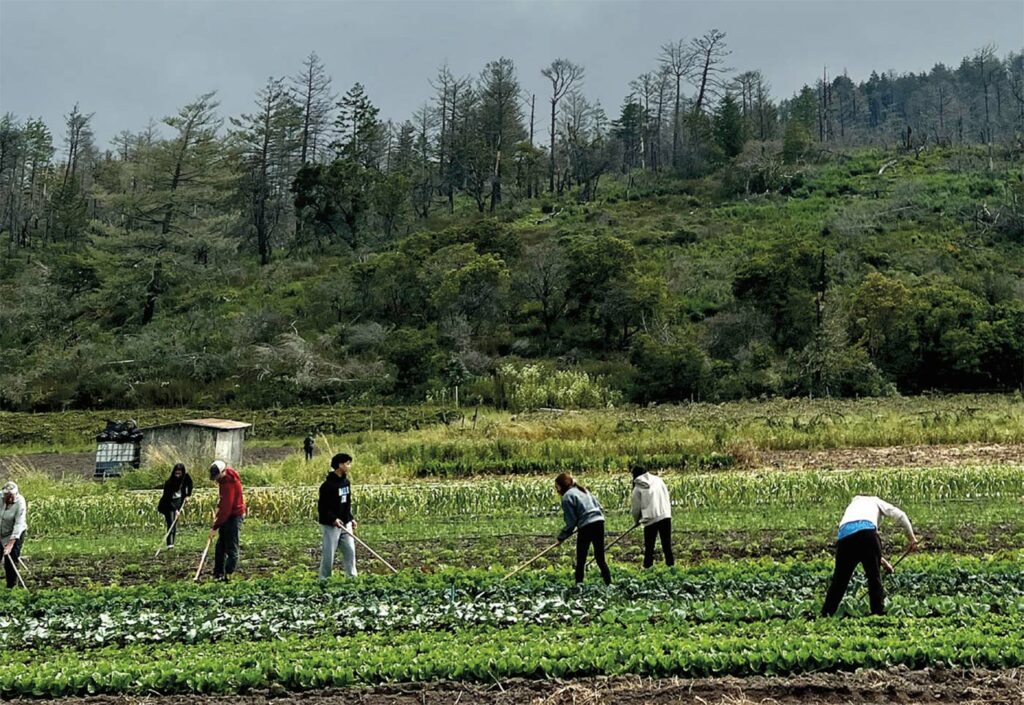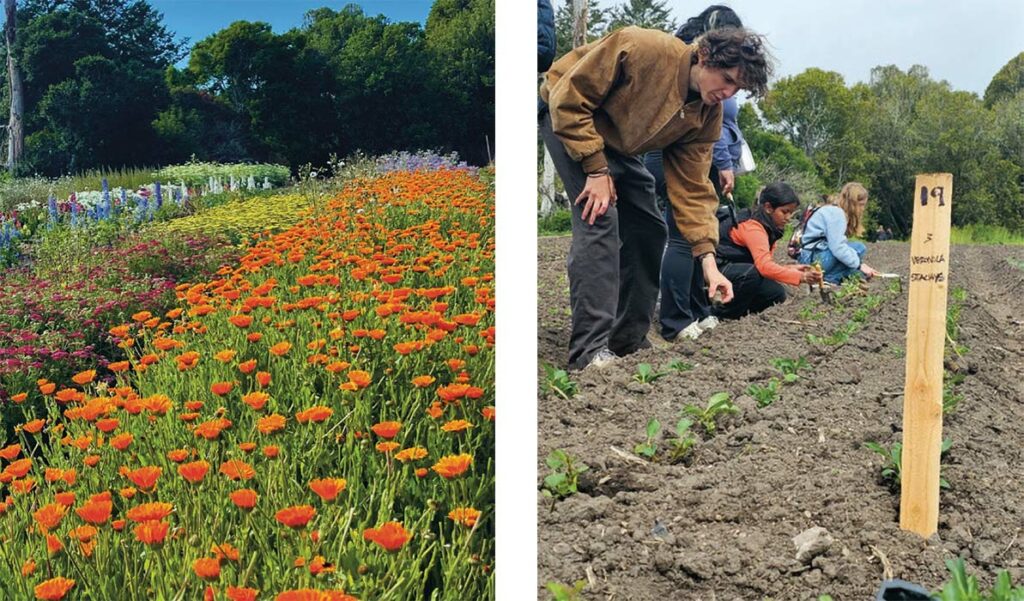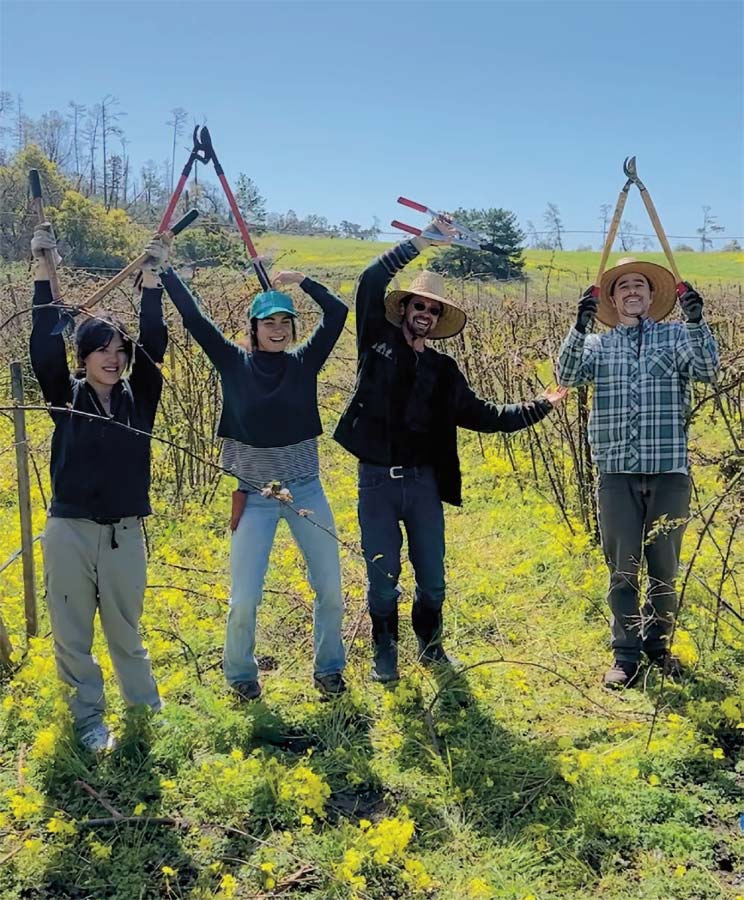
Santa Cruz Permaculture provides hands-on solutions for a more sustainable food system and planet
David Shaw might be best described as a solutionary. The founder of Santa Cruz Permaculture (SCP), an educational center and working farm located between Davenport and Pescadero, espouses an ethos he calls “LIBTYFI” or “Leave it better than you found it.”
“I started Santa Cruz Permaculture specifically to support people in their quests towards right livelihood, also described as working in service of the people and planet, and to be a stone in the bridge of social transformation,” says Shaw. “Permaculture is about permanent culture and living on the planet as if we humans wanted to be permanent inhabitants, and thus leaving things better than we found them for future generations.”
Permaculture, as defined by co-founder, Australian scientist and biologist Bill Mollison, is “the conscious design and maintenance of agriculturally productive ecosystems which have the diversity, stability and resilience of natural ecosystems…the harmonious integration of landscape and people providing their food, energy, shelter and other material and non-material needs in a sustainable way.”
Shaw notes that it’s easy to get caught up in doomerism [despair or pessimism related to global and environmental issues] but “then I connect with my permaculture students and see them learning to catch and store rainwater, regenerate watersheds, care for forests and grow food. Against the backdrop of increasingly complex problems, I see things that are getting better.”

“Caring for people isn’t just feeding their bellies; it’s providing a place for them to nourish their craving for togetherness, a sense of belonging and know-how. As the farm’s bounty grows, so will our ability to furnish these opportunities for people care.” —Leah Stern, Santa Cruz Permaculture
Shaw’s academic background has provided the building blocks for Santa Cruz Permaculture. A PhD student in environmental studies at UCSC, he is focused on agroecology, political ecology and sustainable communities, and is a graduate of the University’s Center for Agroecology’s apprenticeship program. Shaw is a co-founder and coordinator of the Right Livelihood Center at UC Santa Cruz, which was established in 2013. Through his work there, he connects with academics and activists including notables like Vandana Shiva, Wes Jackson and Frances Moore Lappé.
Since its founding in 2016, Santa Cruz Permaculture has offered courses in permaculture design and advanced permaculture, and skills-building classes like herbalism and medicine-making, food forests and regenerative beekeeping.
Then in April 2022, the group took a huge step forward by leasing a 26-acre organic farm, where Shaw and his team and students have been able to grow a diverse array of food and medicinal crops for their CSA, which operates from June to November.
This year the farm has started selling produce at the Santa Cruz Westside Farmers Market and to Wild Roots Market in Felton. Shaw hopes to soon supply local chefs and restaurants. The farm is a bootstrapping enterprise that brings people together to learn the principles of permaculture and food cultivation, as well as build community.
“Our courses support the farm, and our farm supports the learning goals of our students,” says Shaw. “Students have the hands-on space for projects, and we’re creating a workforce development program to help people transition to careers in sustainability and social justice as well as provide skills-building classes that are immediate and practical.”
Prior to finding the farm, Shaw had been dreaming of adding a hands-on agricultural component to Santa Cruz Permaculture. He learned about the gorgeous and inspirational parcel through word of mouth, but the land has an auspicious history. Before Shaw found it, Jim Cochran cultivated strawberries on the property for nearly 30 years as part of Swanton Berry Farm.
Cochran was the first in the area to grow organic strawberries with commercial success, and the first certified organic strawberry grower in California. In 1998, Swanton Berry Farm also became the first farm in the United States to sign a contract with United Farm Workers. Cochran has long been considered a hero of regenerative agriculture and he’s still at it, farming just down the road near the farm store.

It’s the perfect setting for utopia, right on Highway 1 between the cute tiny towns of Davenport and Pescadero. It’s also right across the highway from iconic Año Nuevo State Park, where elephant seals go to frolic, sleep—and mate. It’s near Costanoa Lodge, as well as Pie Ranch, which is a regenerative teaching farm for school kids. Pie Ranch has a farmstand full of culinary goodies that’s hard to drive by without stopping. No doubt, there’s a lot to see and do on this part of the coast.
Since signing a lease for the farm, Shaw and his crew and students have worked to transition it into a regenerative, no-till, mixed vegetable, fruit, flower, herb and agroforestry operation. The goal, says Shaw, is to push the limits of regenerative agriculture to increase biodiversity, resilience and community.
“We’re tending to the ancient oaks, buckeye and bay trees originally tended by the Quiroste people for thousands of years. We’re also designing a large watershed restoration, and agroforestry and animal integration projects,” says Shaw. “They will, in turn, serve as inspiration for others and we look forward to stewarding this land in a way that conserves and regenerates the living soil food web.”
Santa Cruz Permaculture farm’s first full growing season was a fruitful one. Flowers have been planted to attract beneficial insects and a $105,000 grant for land and water improvement was secured from the Natural Resource Conservation District. Shaw eventually plans to rotate livestock through fields using a low impact grazing method from Portugal and Spain, known as silvopasture. A watercourse and watershed restoration is also planned to repair riparian corridors.
While the farm is in the process of receiving its organic certification, Shaw says he and his team follow organic standards and use additional eco-friendly farming techniques such as cover cropping, compost application and rainwater harvesting.
The rich alluvial soil and coastal climate allow cool weather crops like peas and broccoli to grow year-round. There are also seasonal crops like tomatoes, pole beans, strawberries and a variety of caneberries including olallieberries, tayberries and blackberries, cut and edible flowers, culinary and medicinal herbs, and prepared foods like jam and medicinal herb teas. There are plans to expand cultivation to include more perennial flowers, willow for baskets and living structures, elderberry and other medicinal herbs and Kernza, the world’s first perennial grain.
For SCP’s marketing and communications consultant Leah Stern, the farm and courses benefit the teachers as much as the pupils. “One thing we’ve loved about starting a permaculture farm is that our students aren’t walking into the finished product, and maybe wondering how they can ever get there,” she says. “They’re right there with us, designing from the ground up, observing and redesigning, which is such an important learning process.”

WHAT IS PERMACULTURE?

It’s a perennial question and the answer is, “It depends.” For many it is simply a paradigm shift. It is also a contraction of “permanent agriculture” or “permanent culture.” A few other descriptors are “a design science grounded in ethics,” and “the art of developing beneficial relationships.” And that’s not the half of it.
Since its founding in Tasmania in 1978 by Bill Mollison and his student David Holmgren permaculture has become a global practice. There are permaculture schools and farms on nearly every continent, as well as local, state, national and international conferences addressing regenerative solutions to issues like climate change, biomimicry, soil fertility and water management, as well as workshops and talks on composting, food forests, perennial crops, habitat design, natural building and more. Permies are a tightly knit network and tend to share high spirits when they converge, because they share profound beliefs and hopes, goals and values—and they love to celebrate.
If you’d like to learn more about permaculture, the following programs are offered in Santa Cruz County:
Cabrillo College: Contractor/landscaper Ken Foster teaches Edible Landscaping as well as a full permaculture design curriculum, with an emphasis on urban homesteads, urban farms and farm gardens. cabrillo.edu/horticulture
Santa Cruz Permaculture: An all-star line up of expert instructors teach courses in permaculture design and advanced permaculture, and skills-building classes like herbalism and medicine-making, food forests and regenerative beekeeping. santacruzpermaculture.com
Vital Cycles Permaculture: Anne Freiwald and Lydia Neilsen offer a woman-centered approach to permaculture, usually taught on a small local farm. They teach the whole permaculture curriculum, but specialize in watersheds and water management, as well as composting and human and environmental health. vitalcyclespermaculture.com
About the author
Jillian Steinberger-Foster is a regenerative landscape gardener and designer. She is co-owner of Terra Nova Ecological Landscaping with her husband, contractor Ken Foster. They have a thriving homestead on the Westside of Santa Cruz and three active rescue dogs.
- Jillian Steinberger-Fosterhttps://www.ediblemontereybay.com/author/jlsteinberger/
- Jillian Steinberger-Fosterhttps://www.ediblemontereybay.com/author/jlsteinberger/
- Jillian Steinberger-Fosterhttps://www.ediblemontereybay.com/author/jlsteinberger/
- Jillian Steinberger-Fosterhttps://www.ediblemontereybay.com/author/jlsteinberger/


